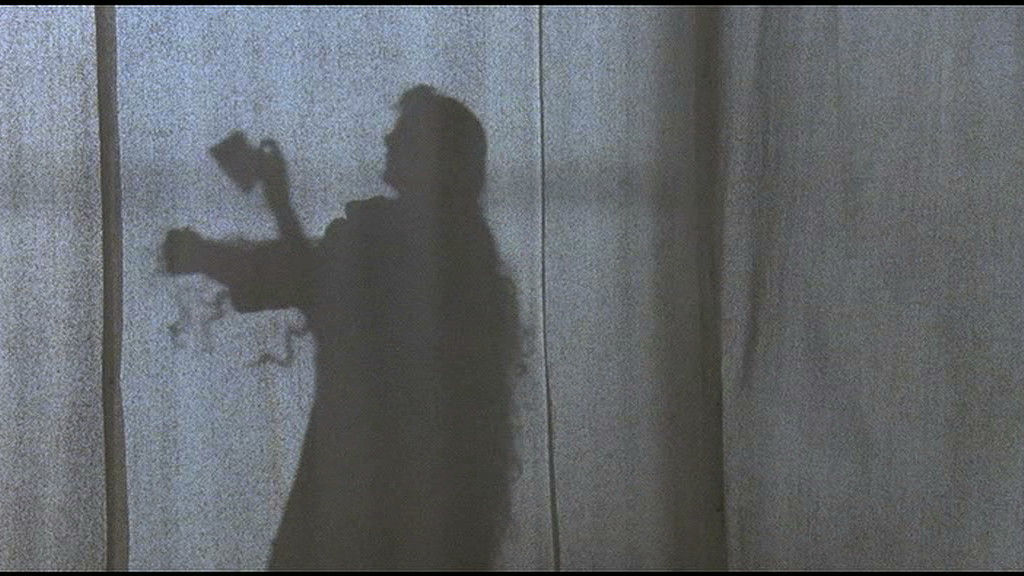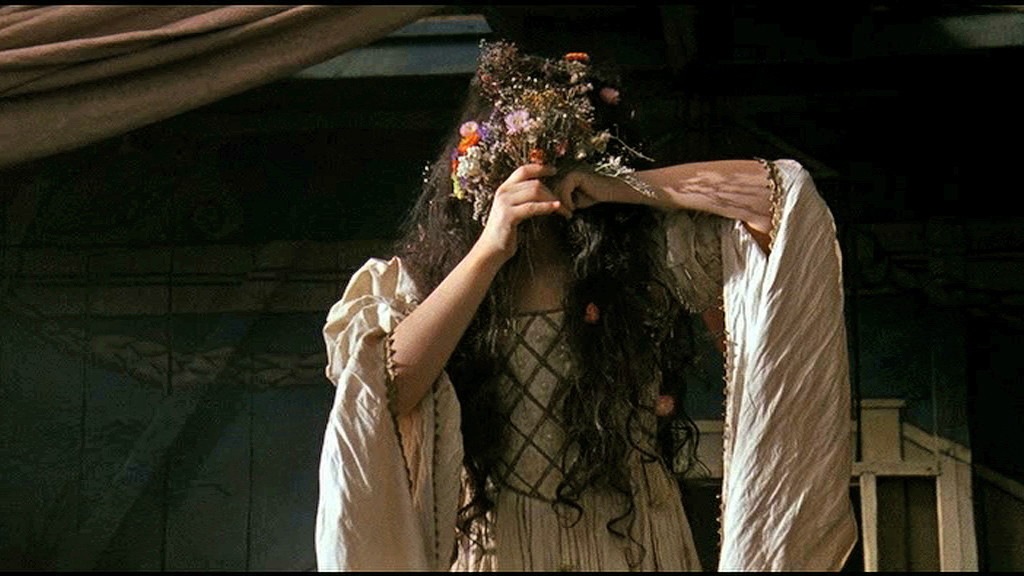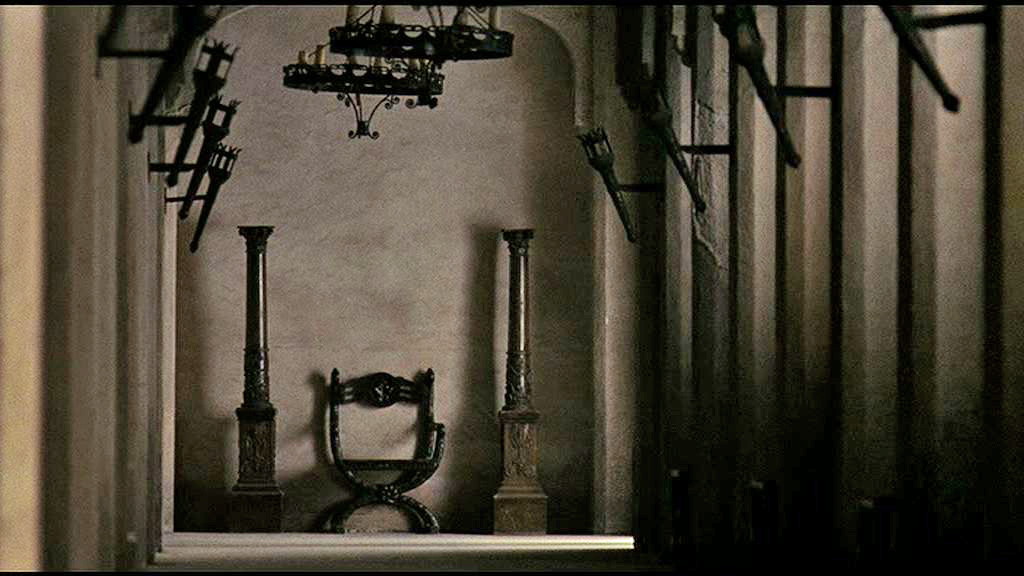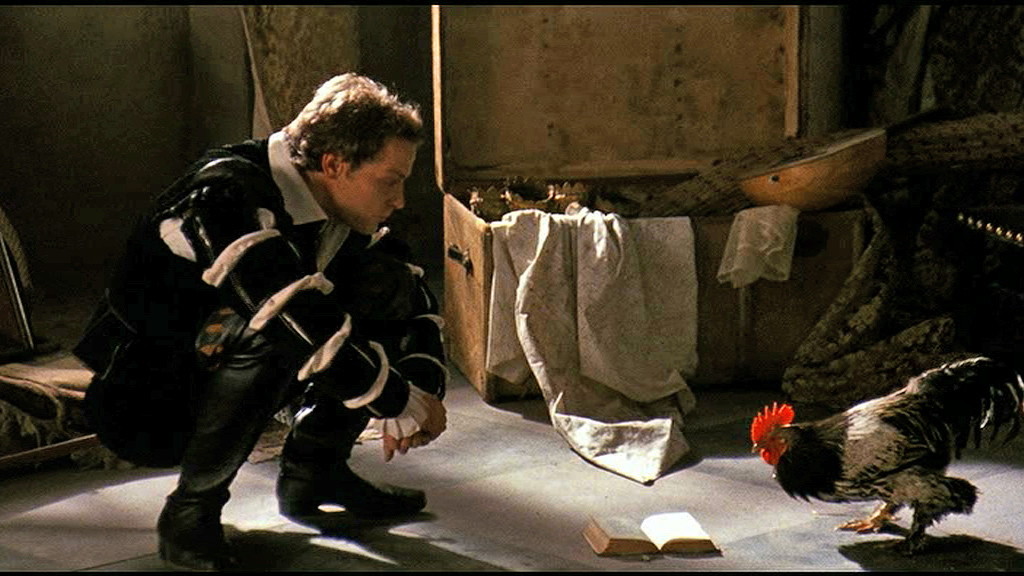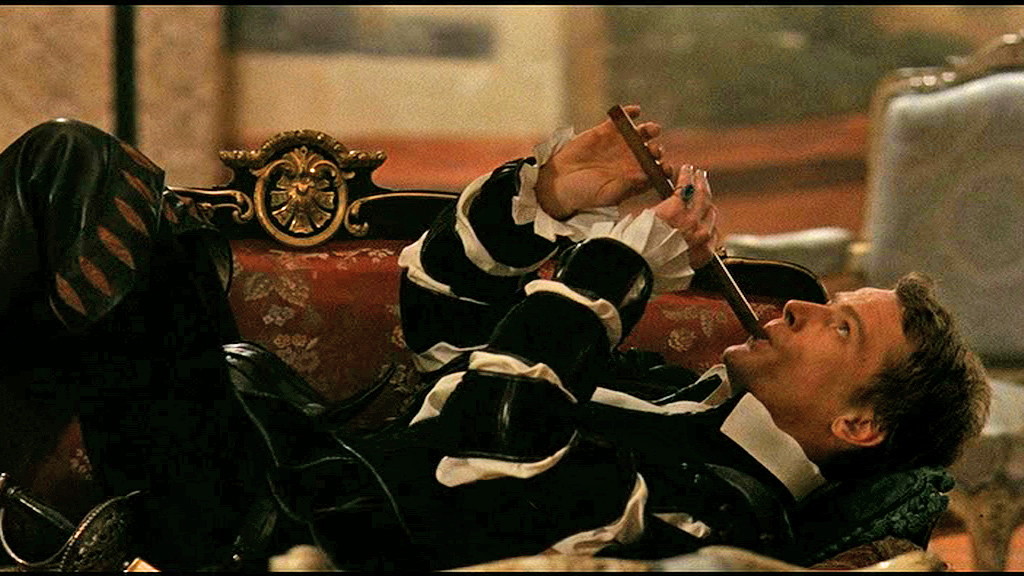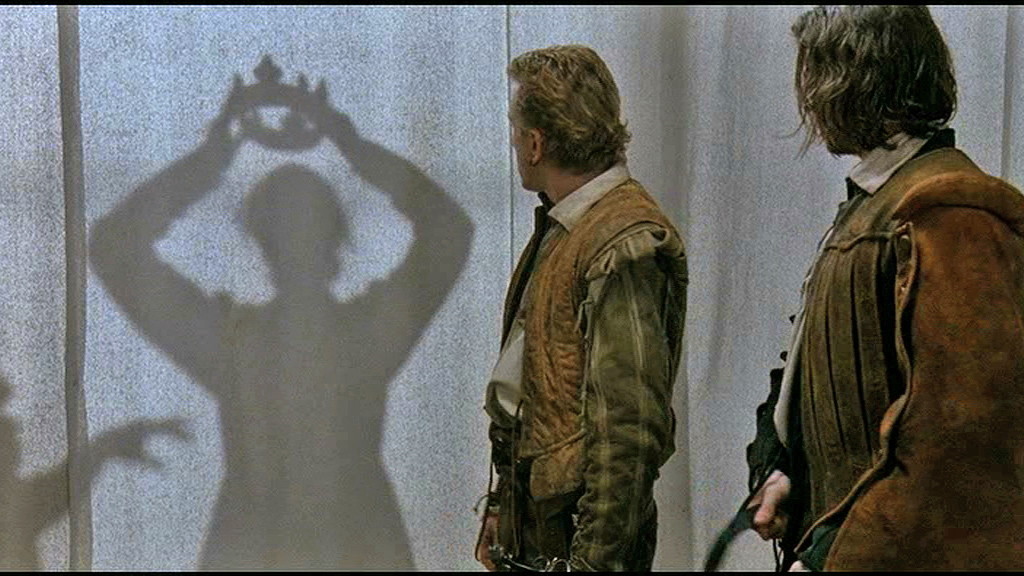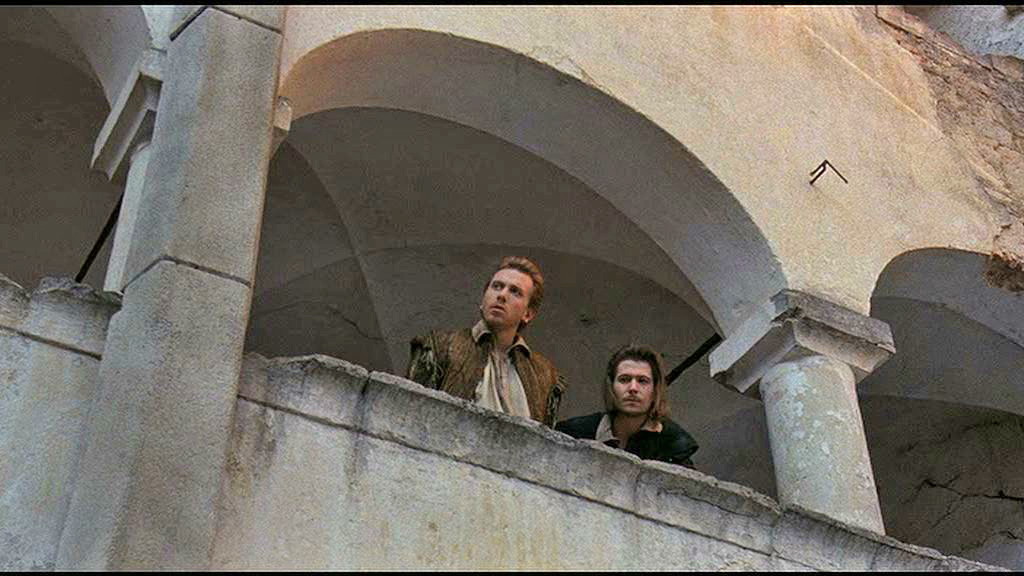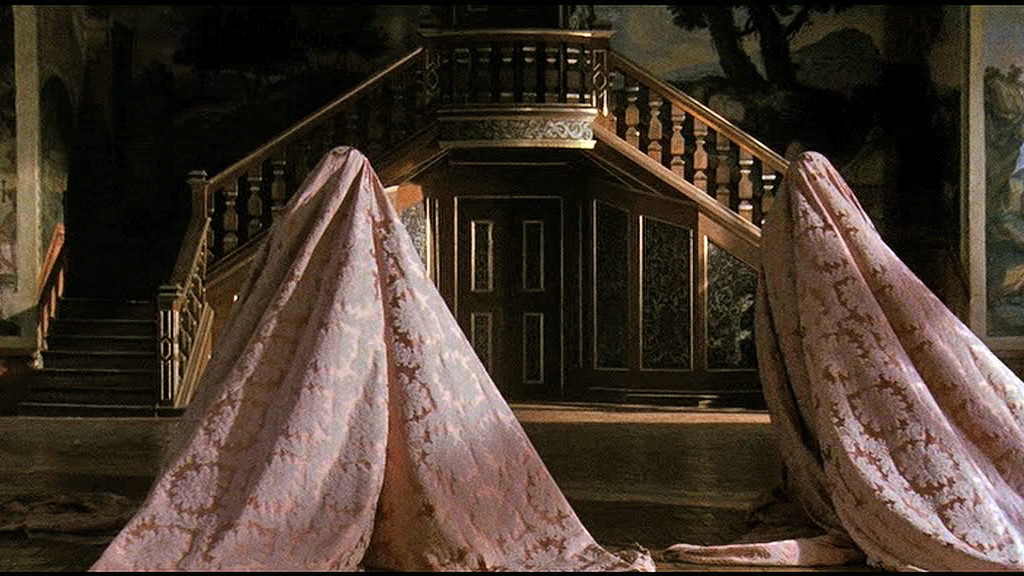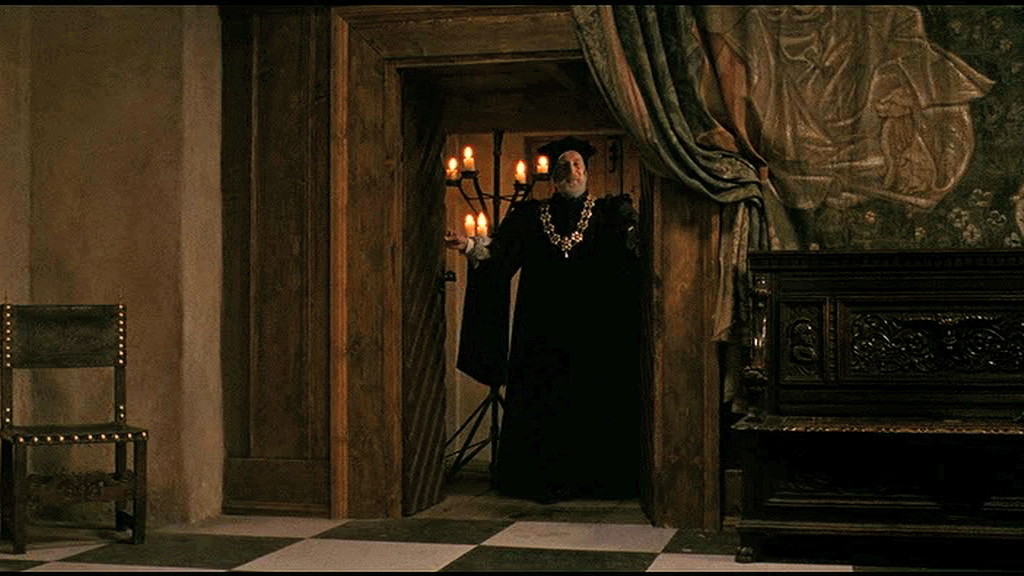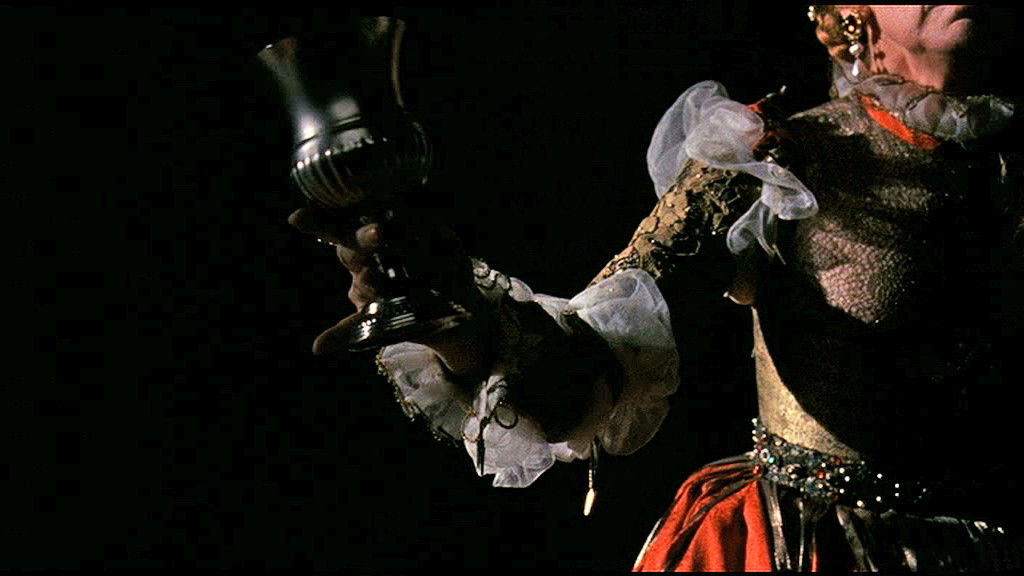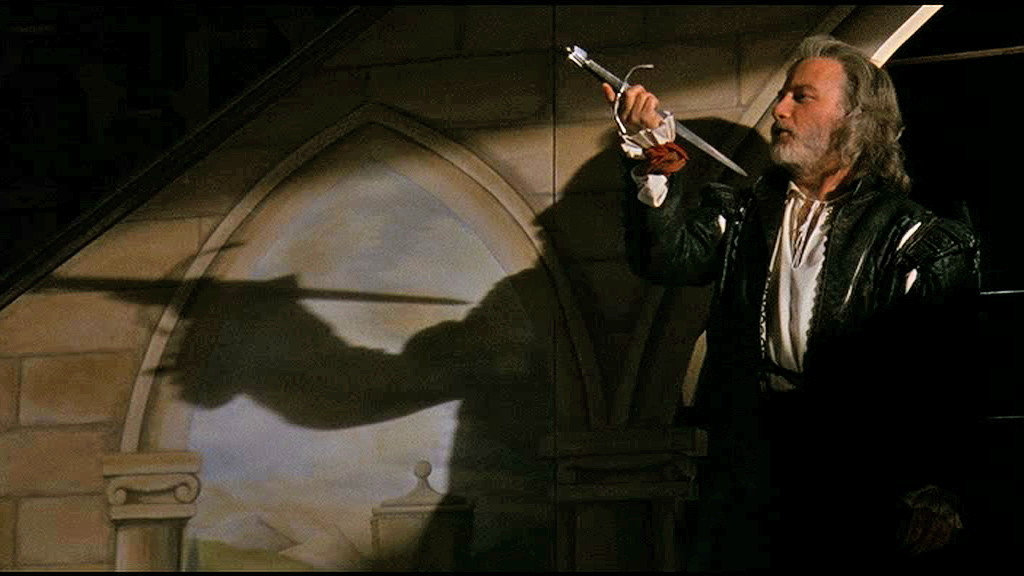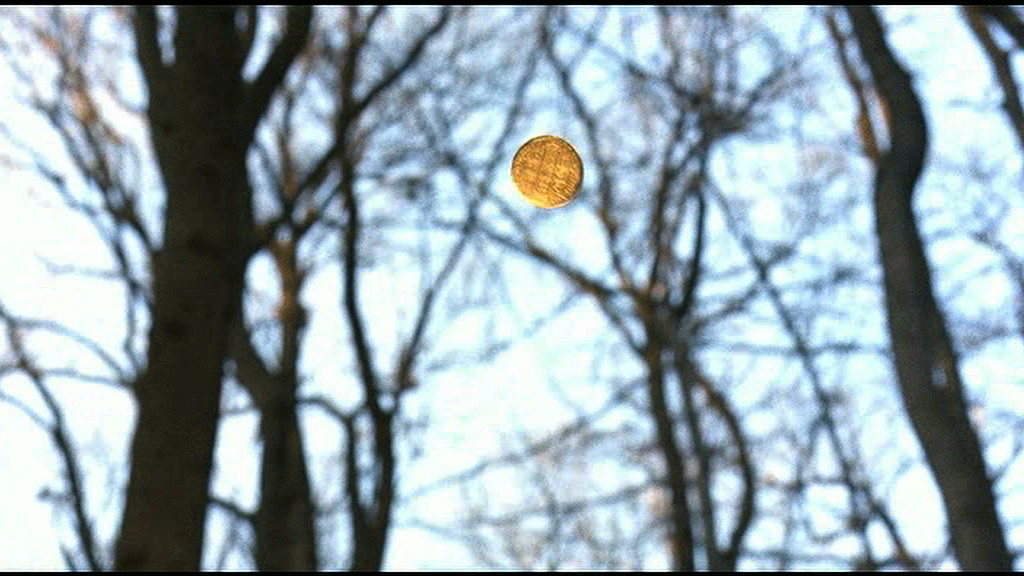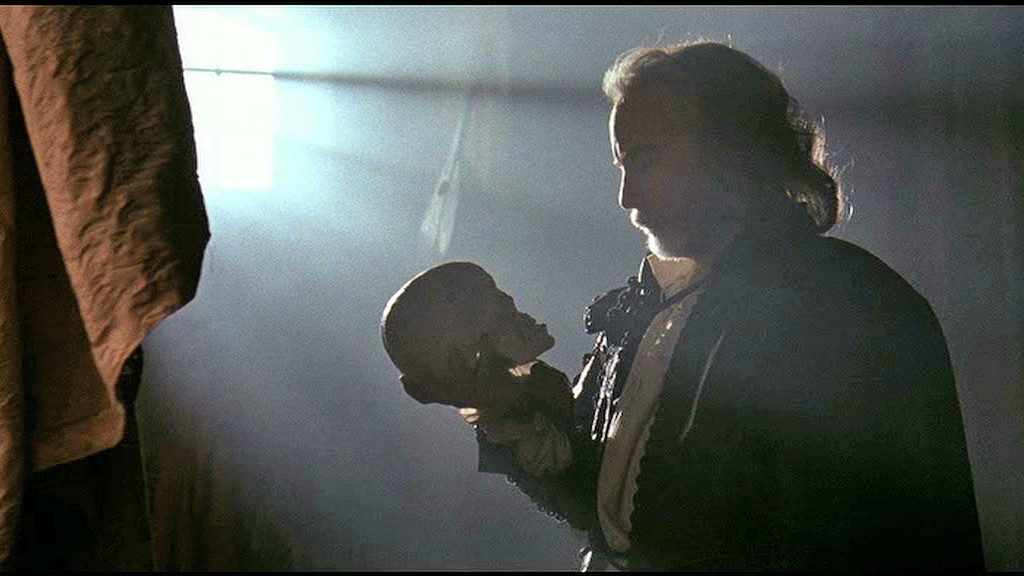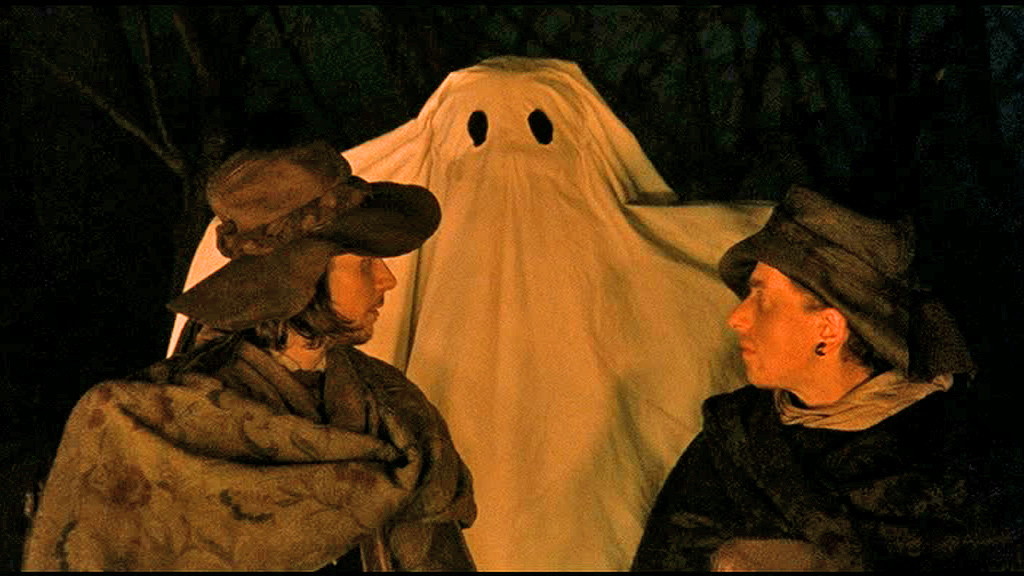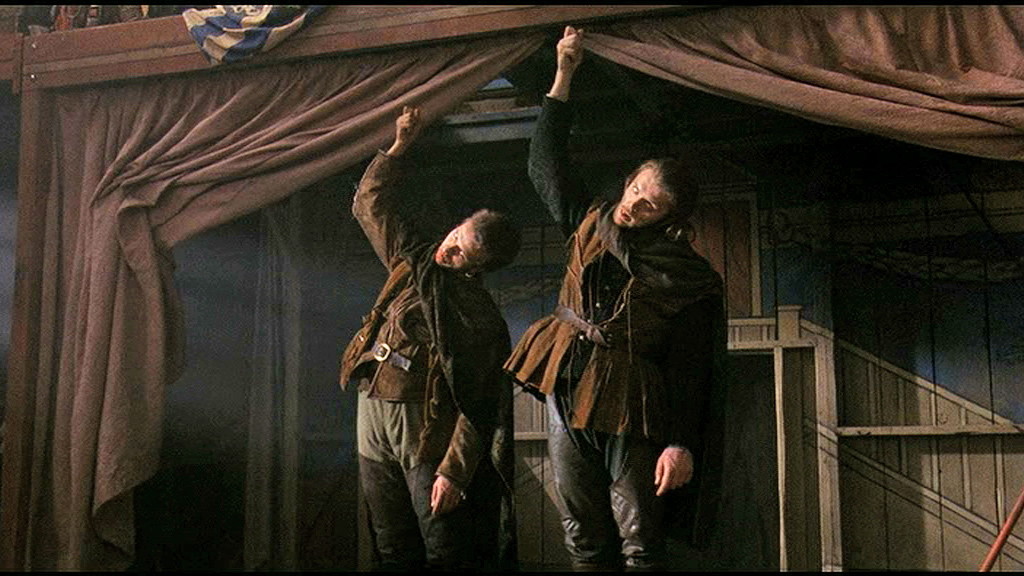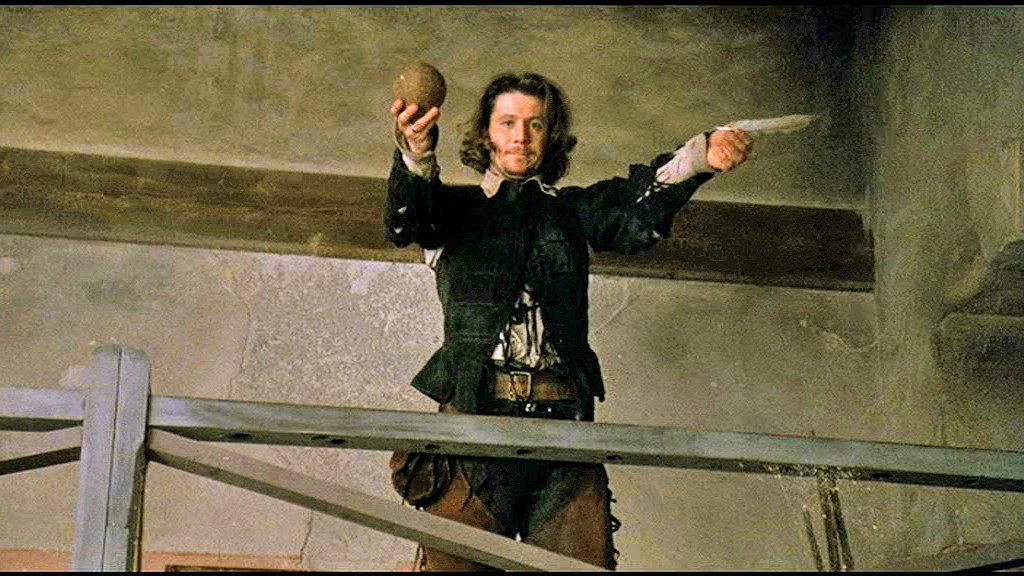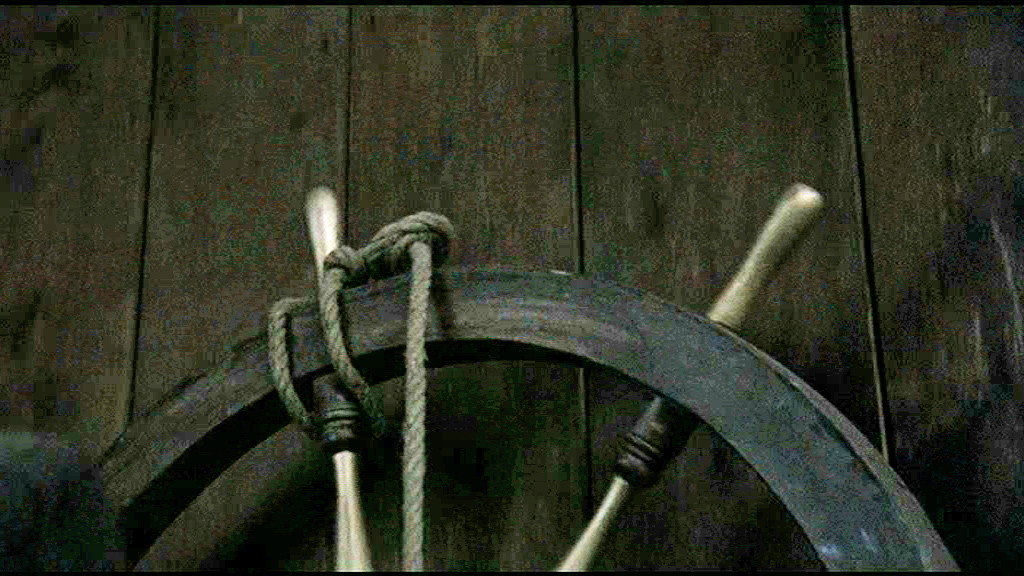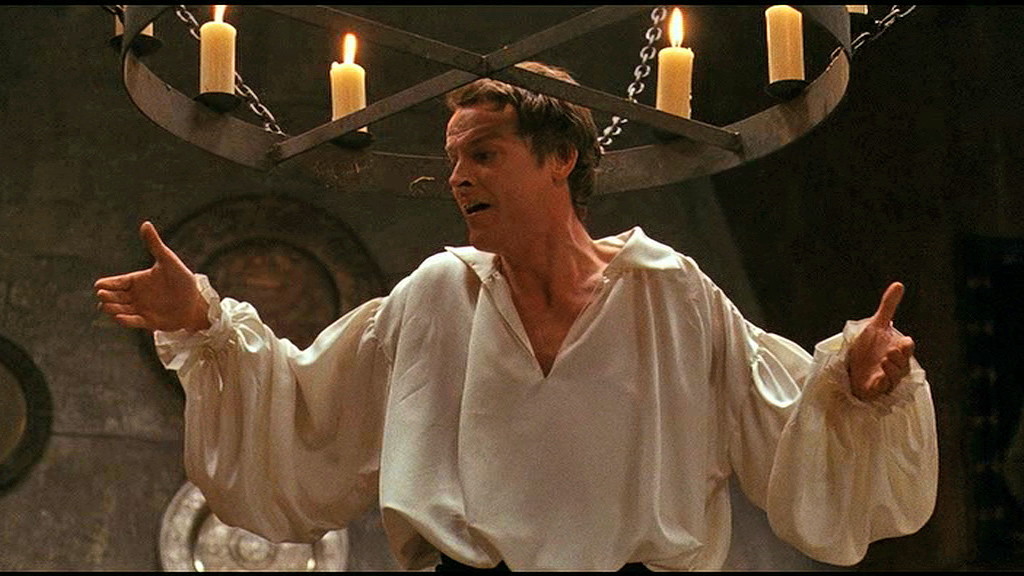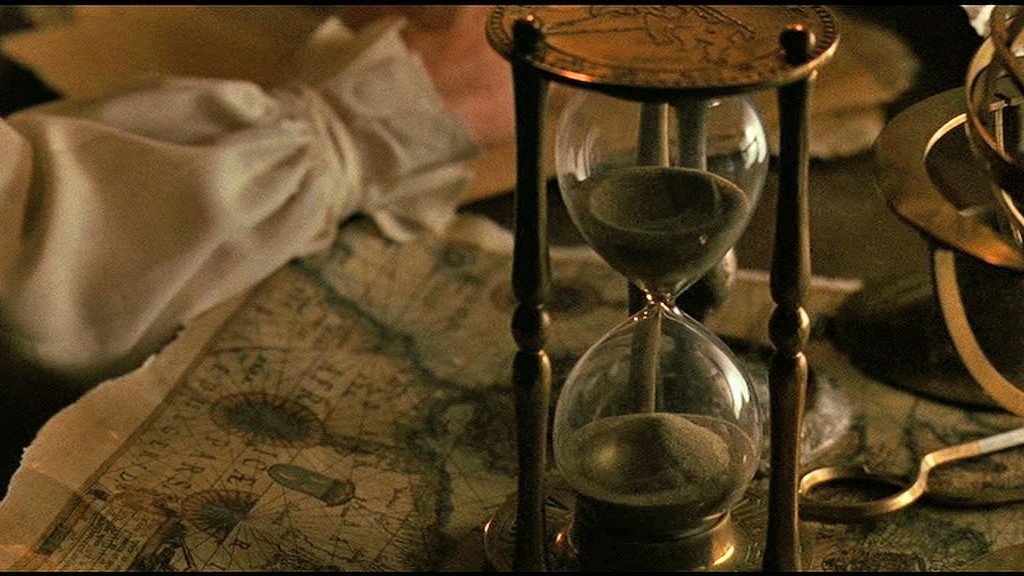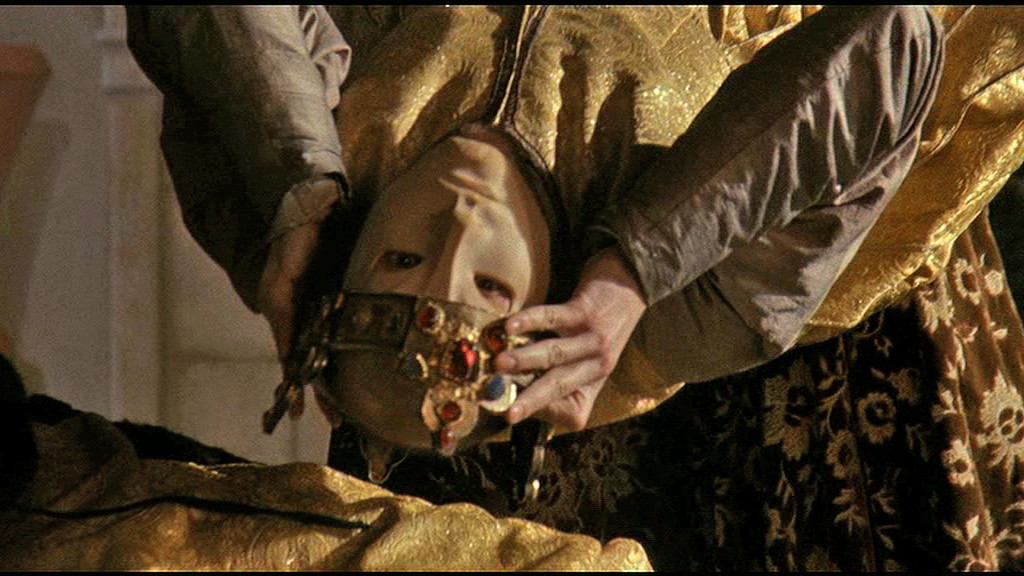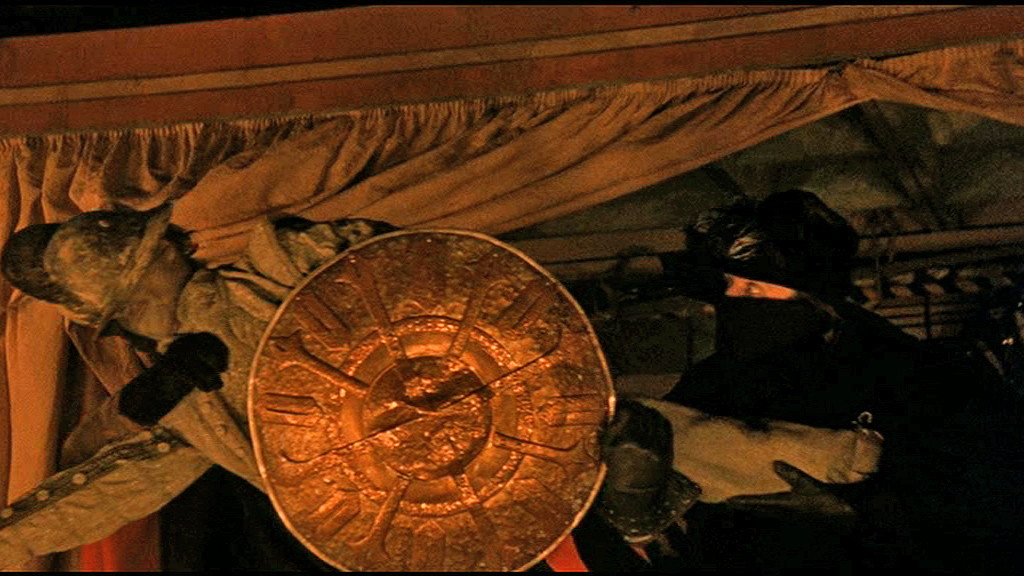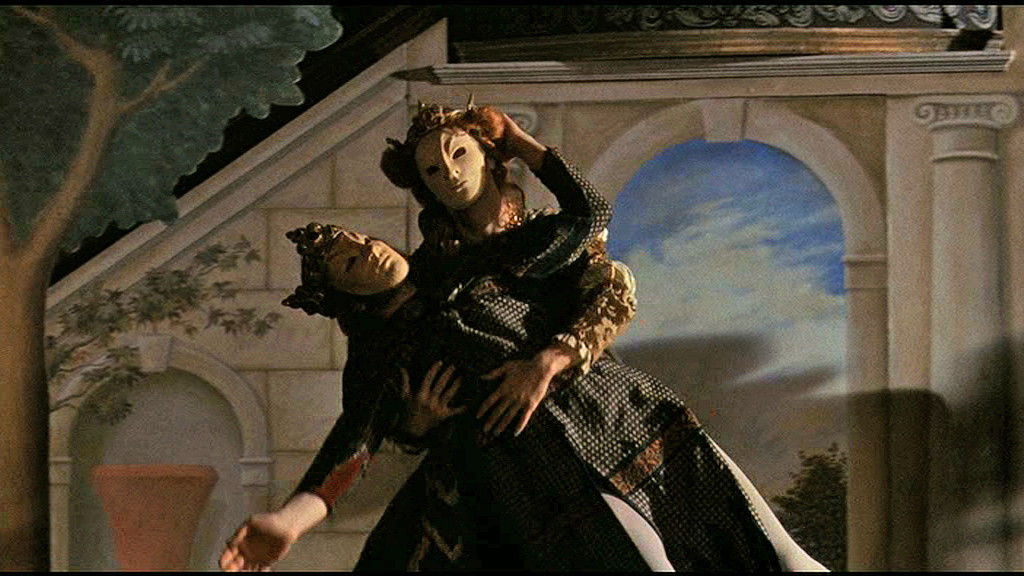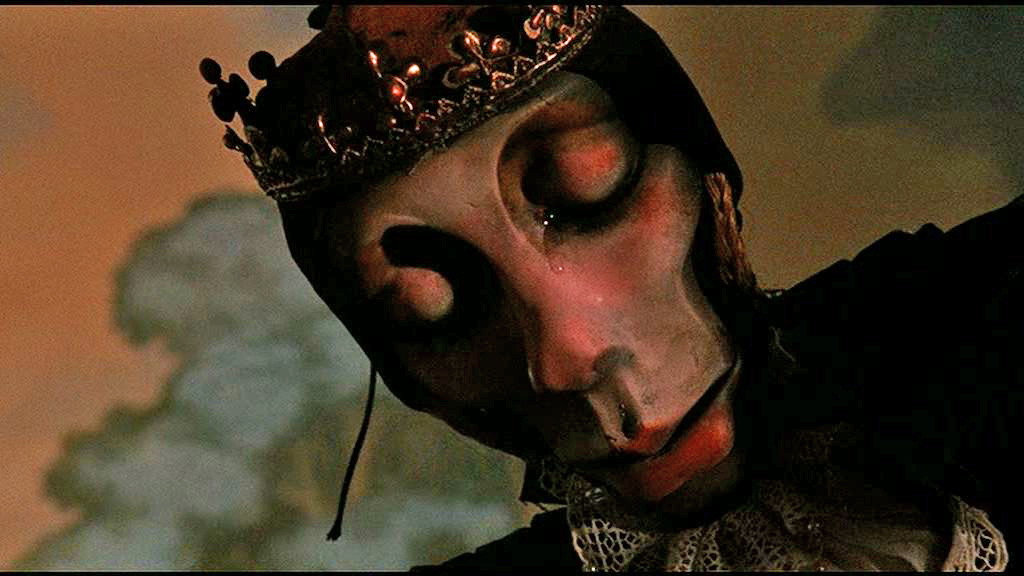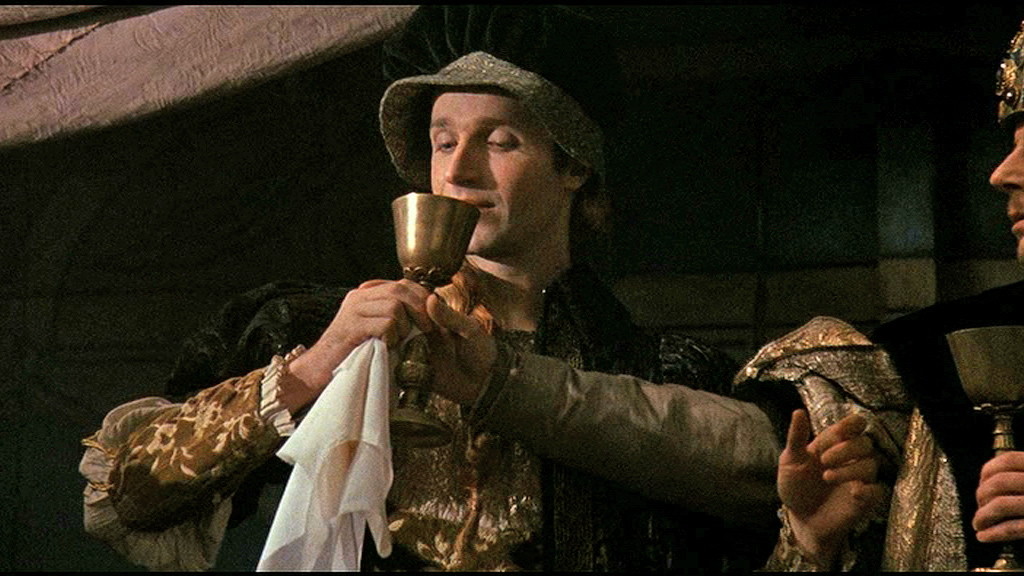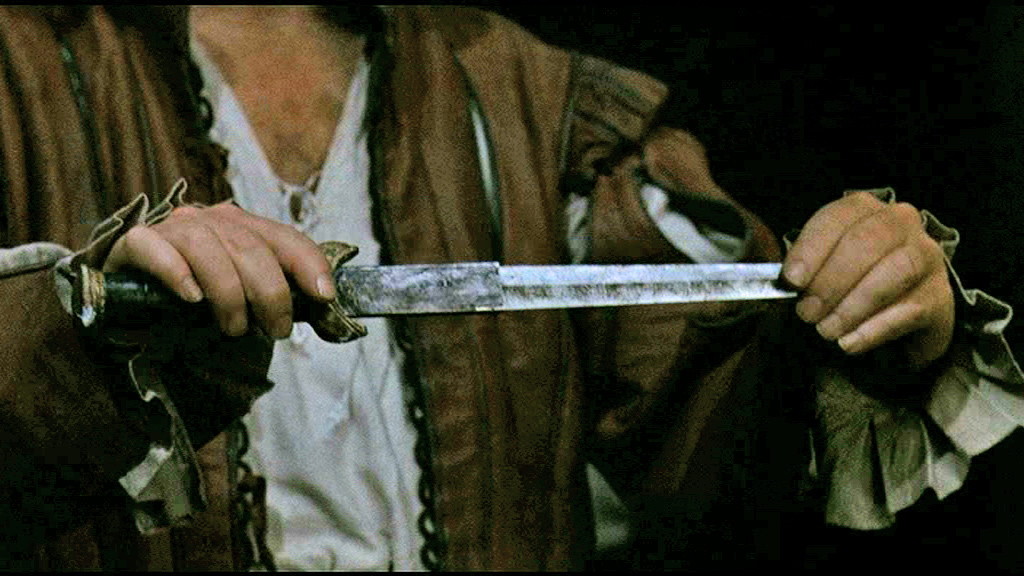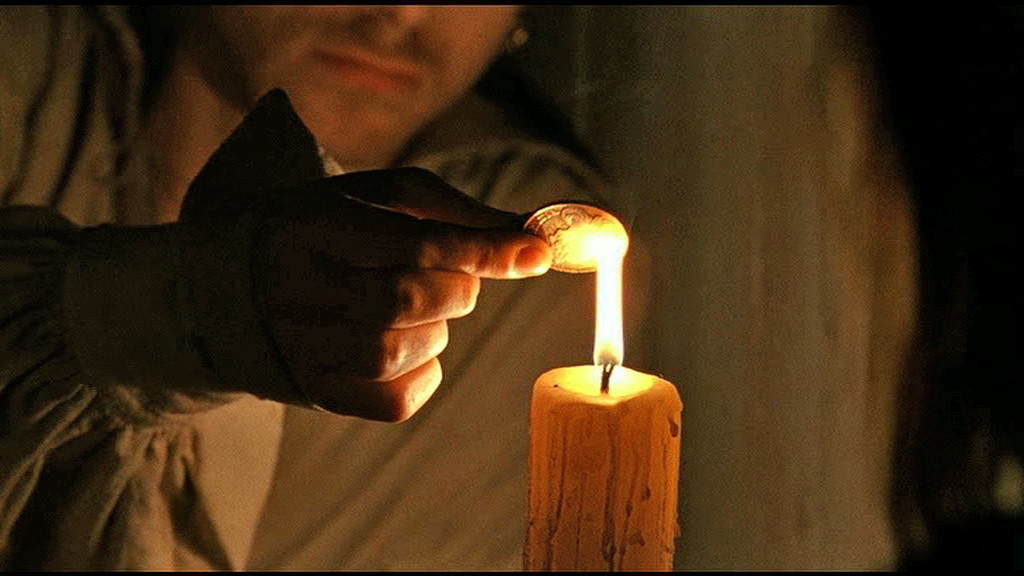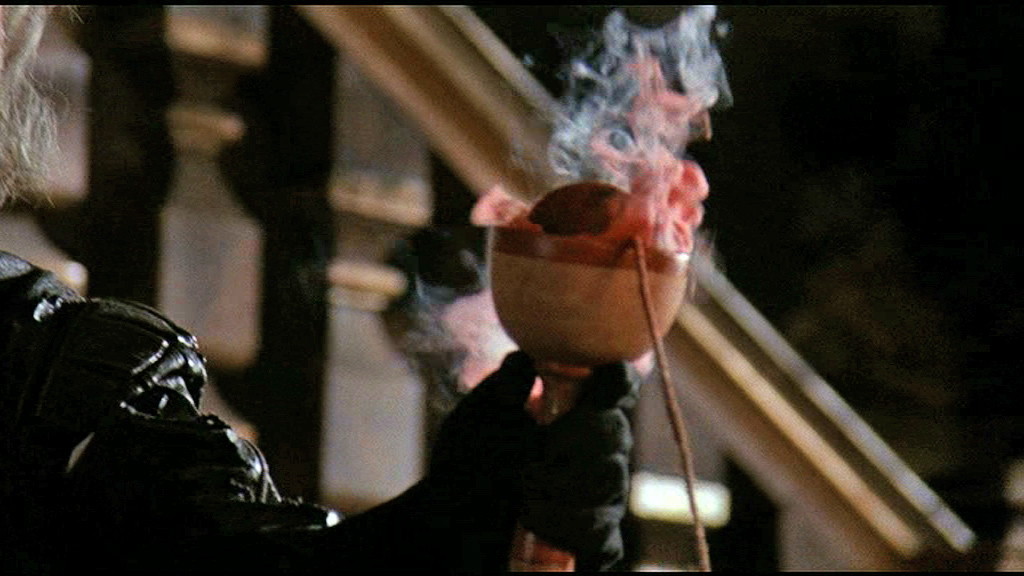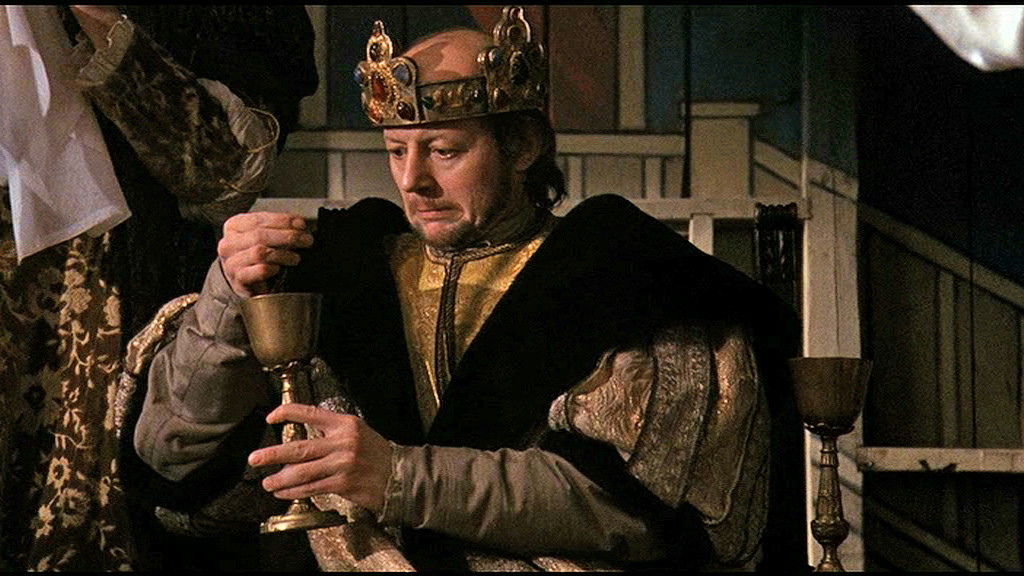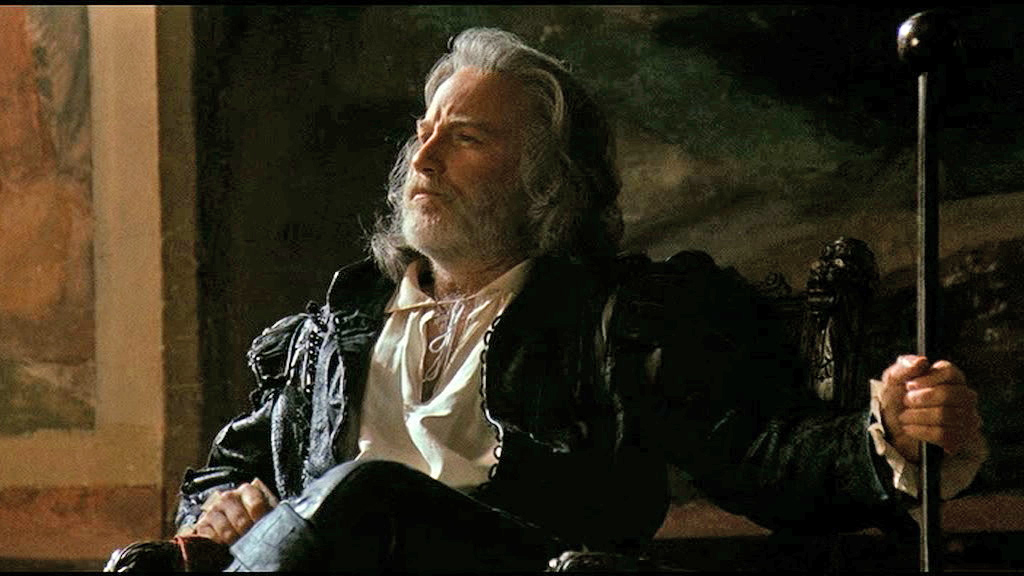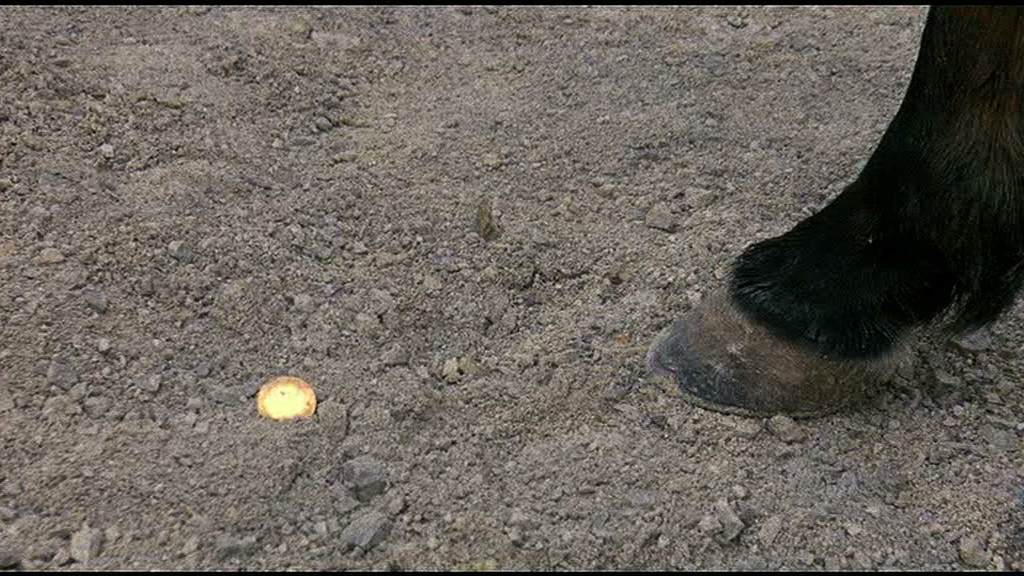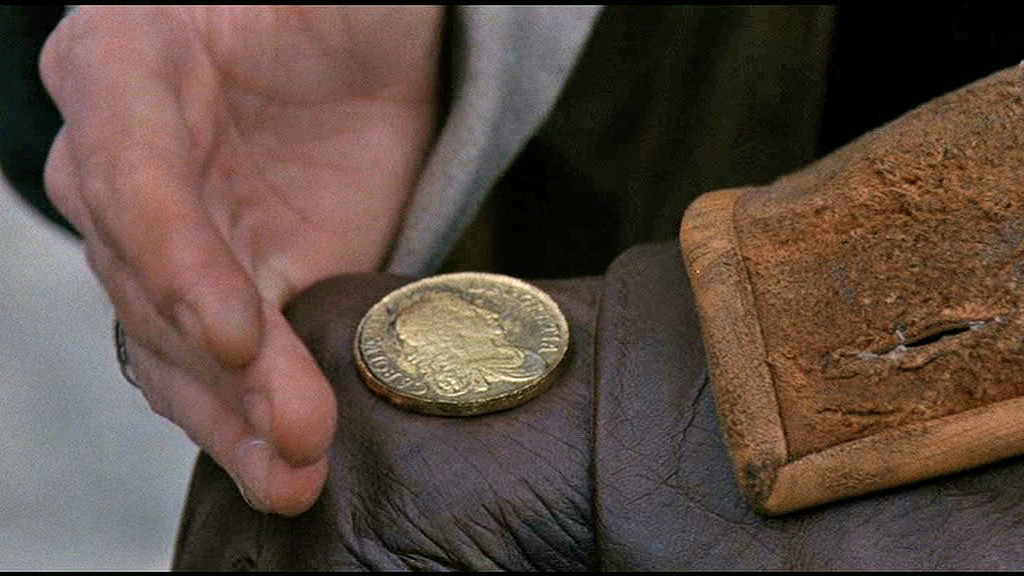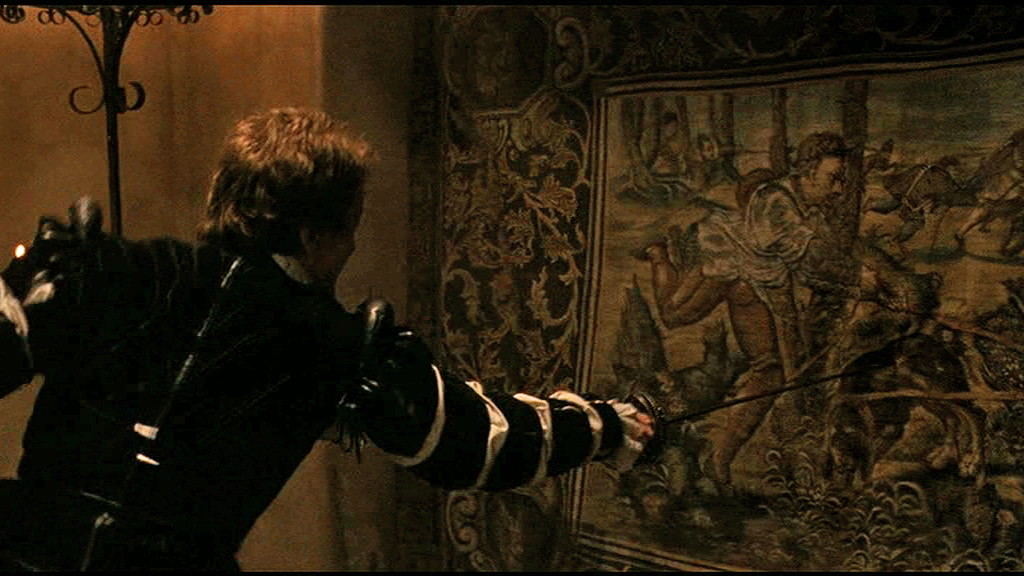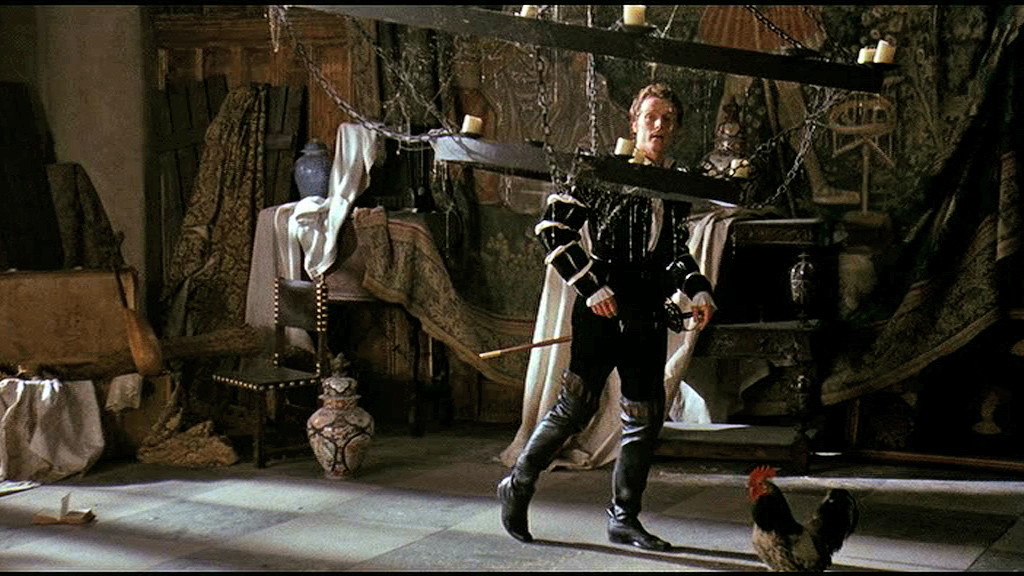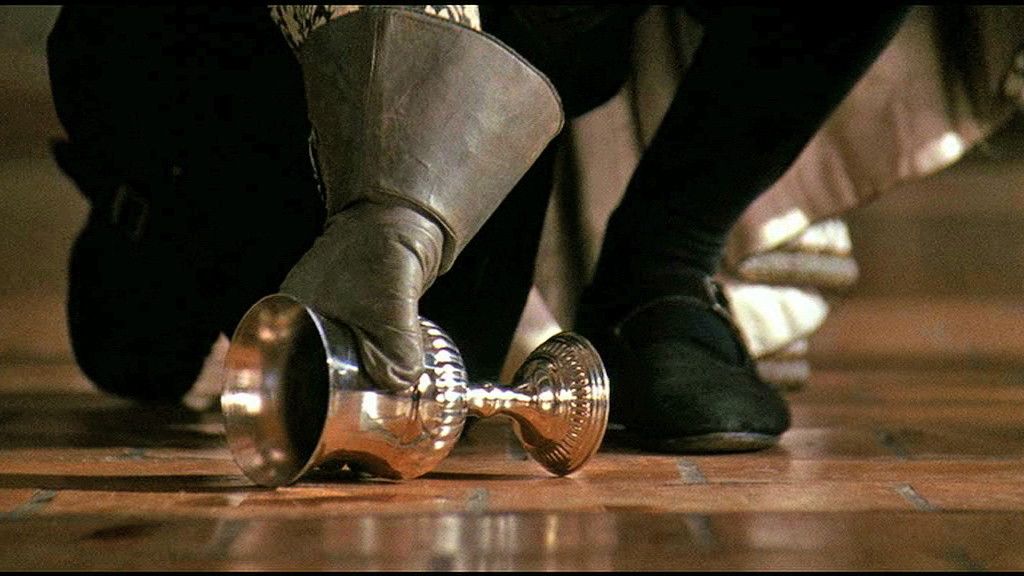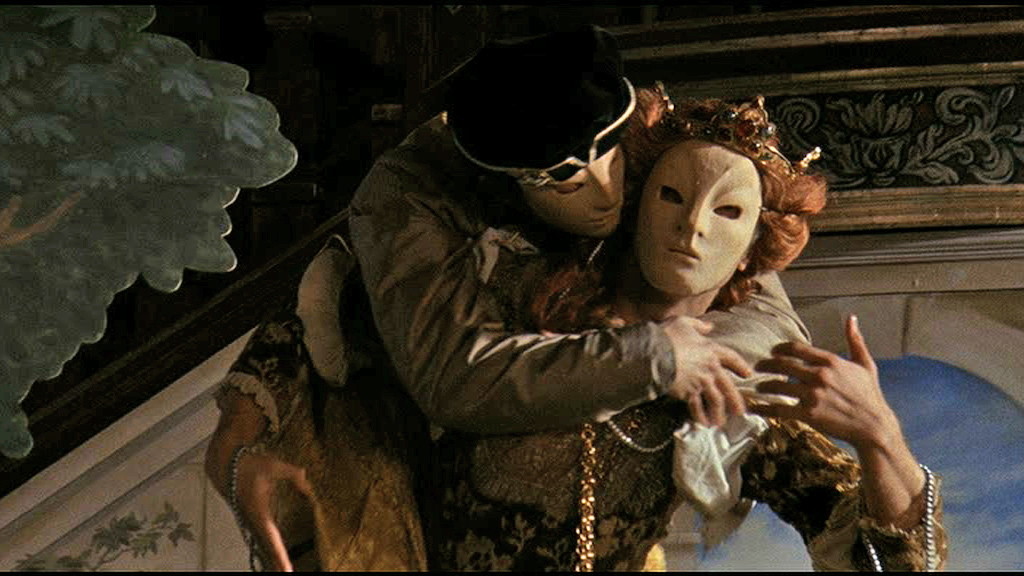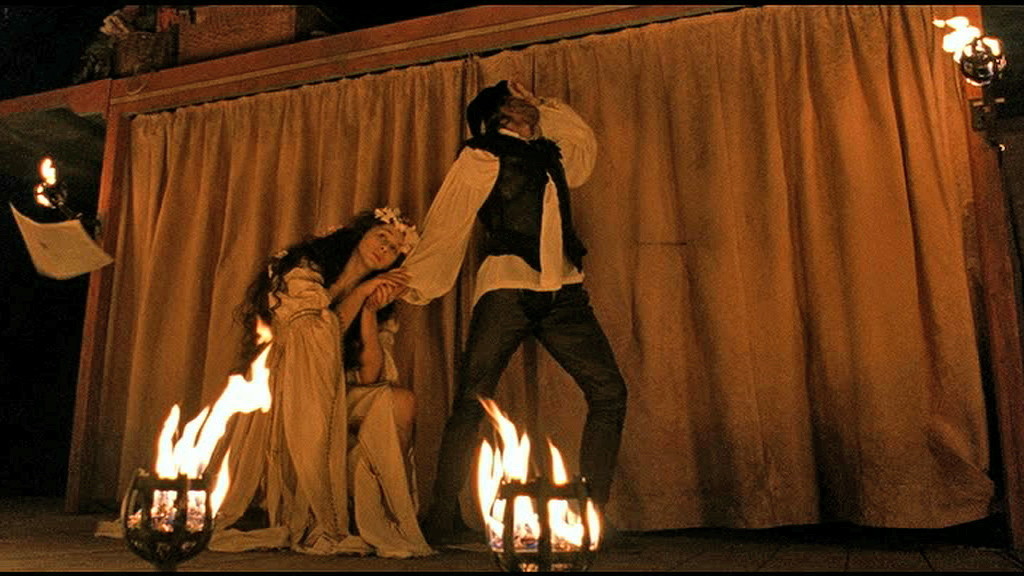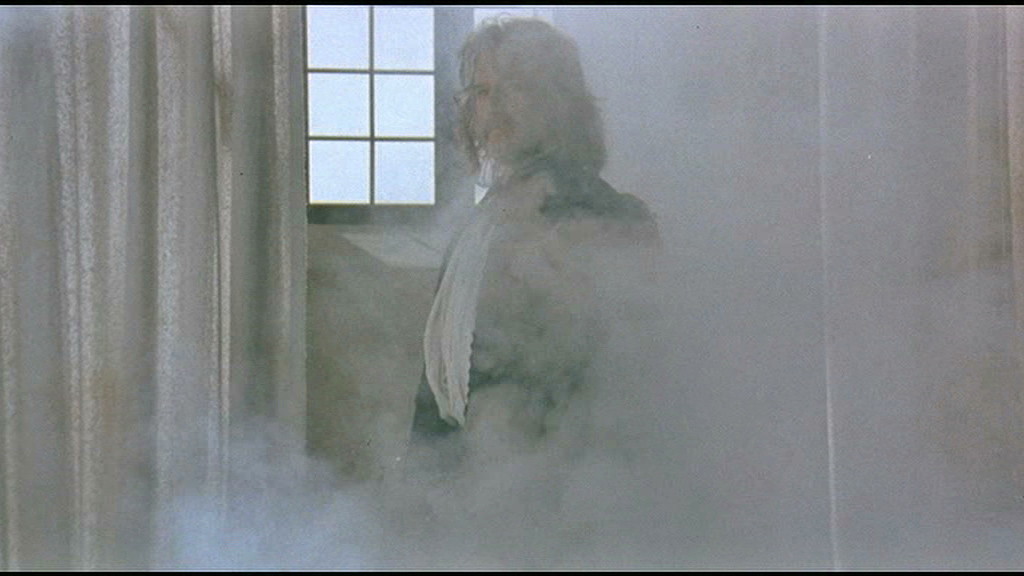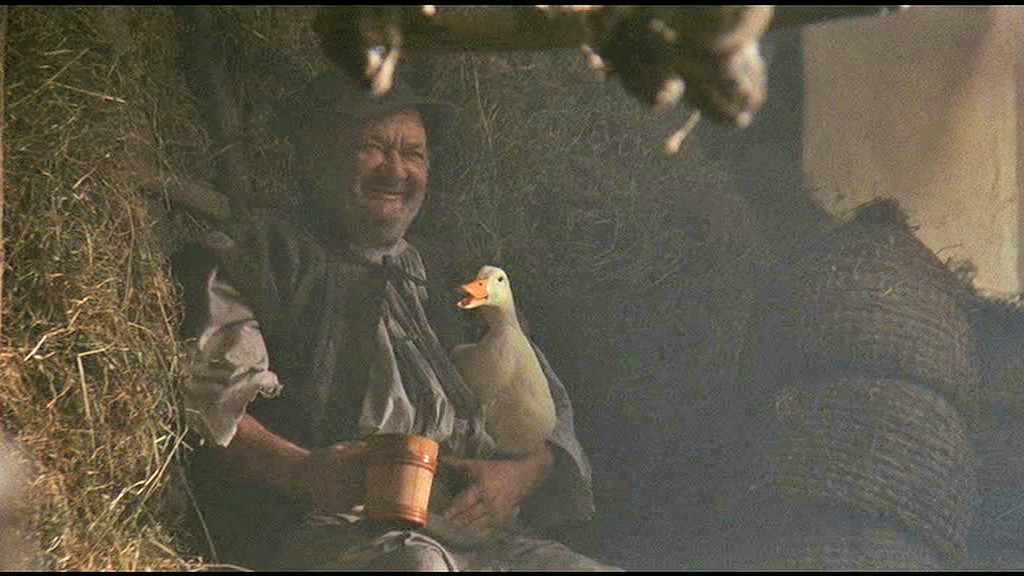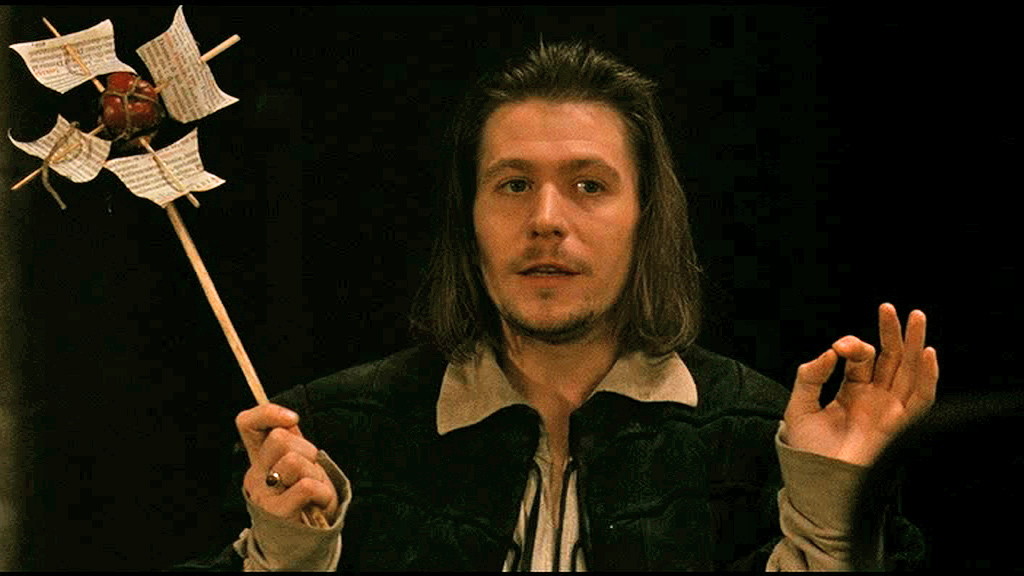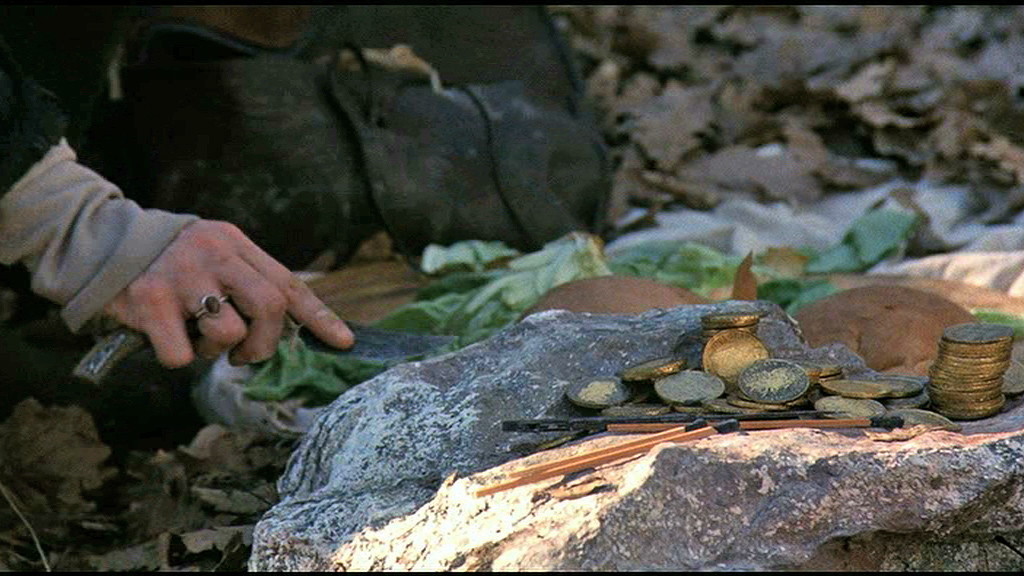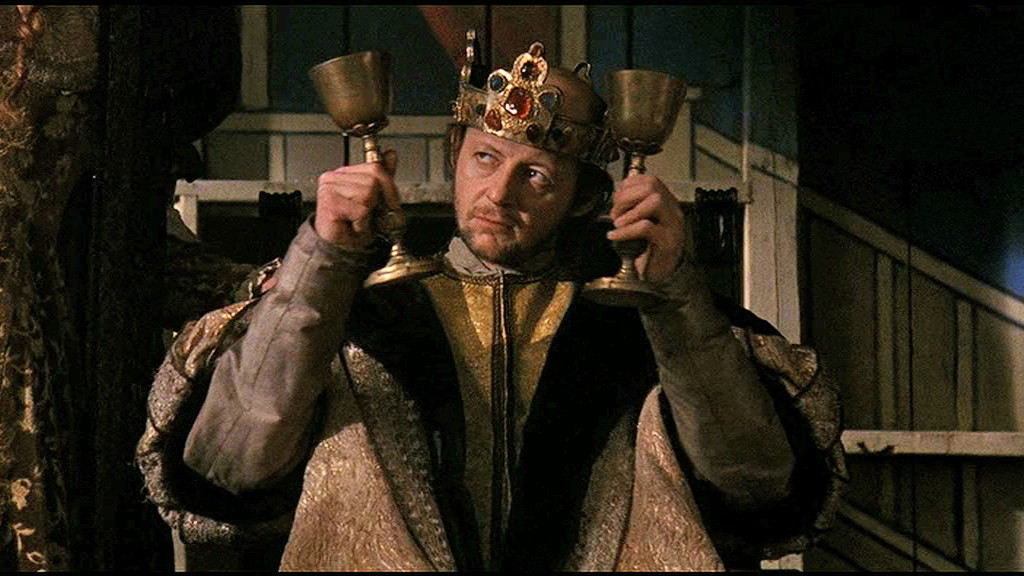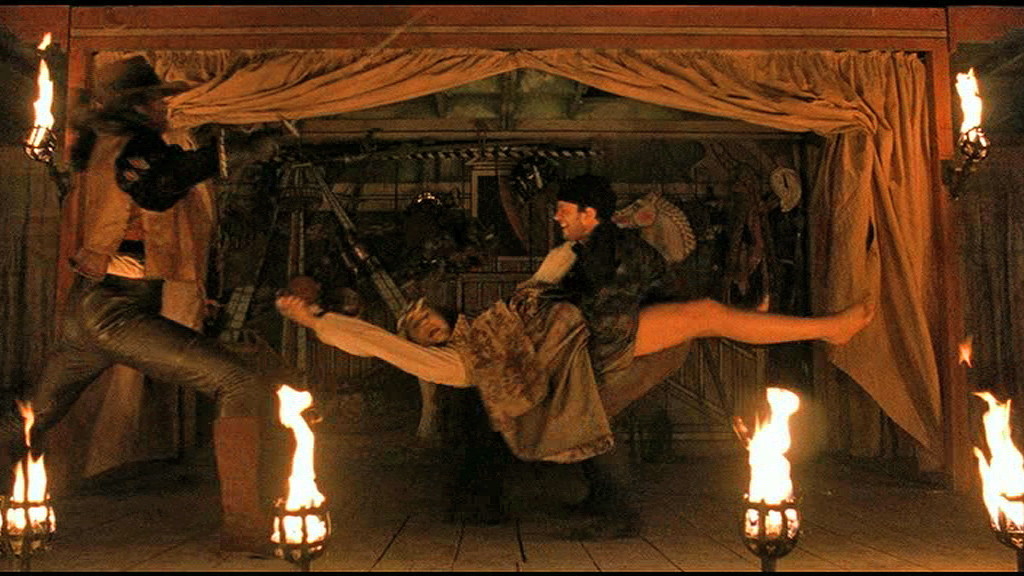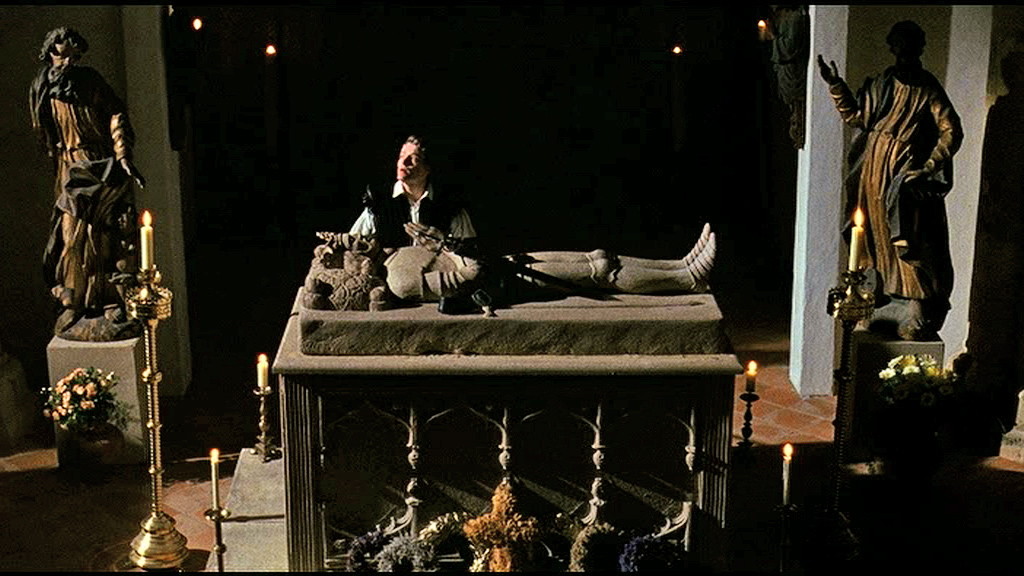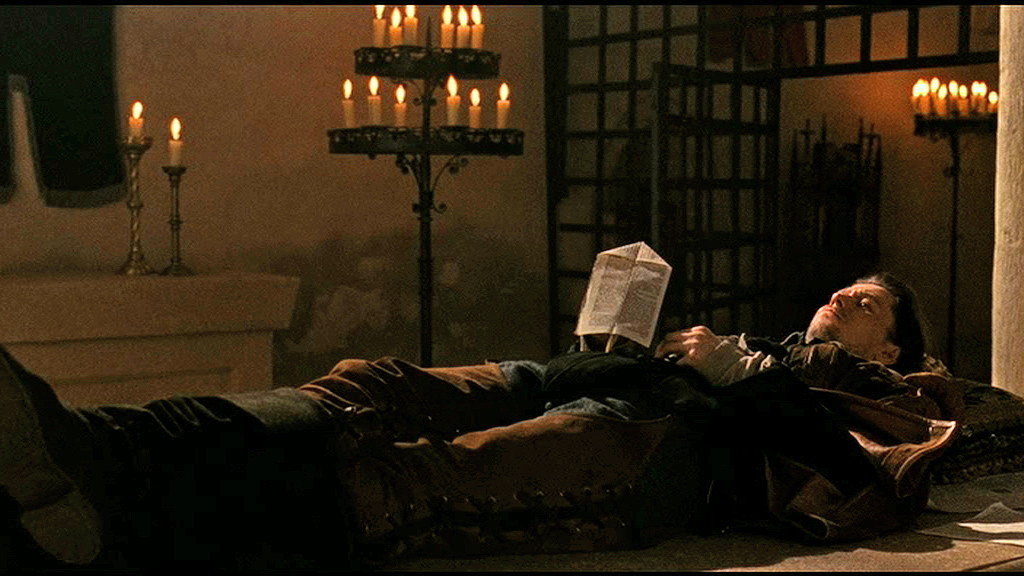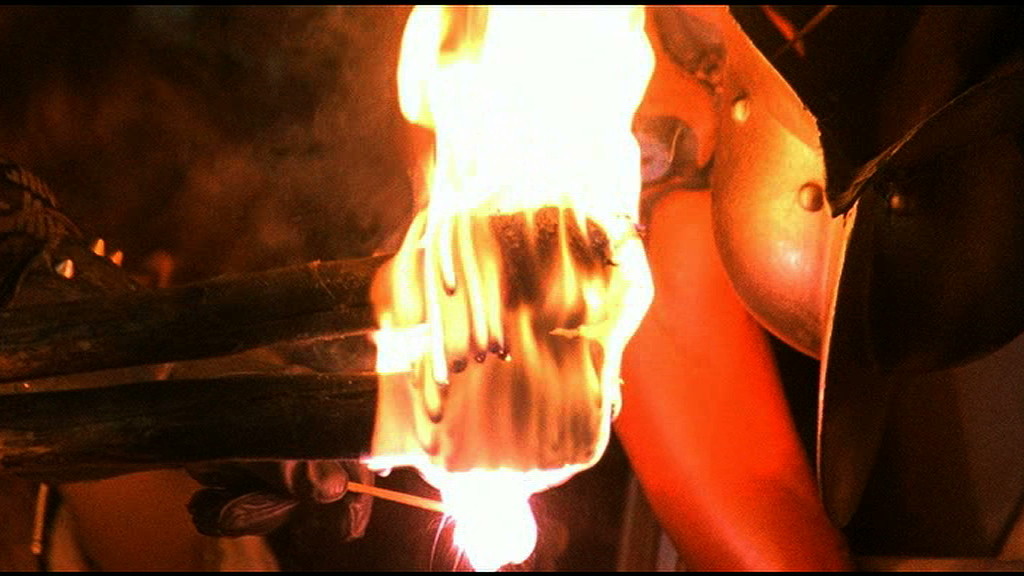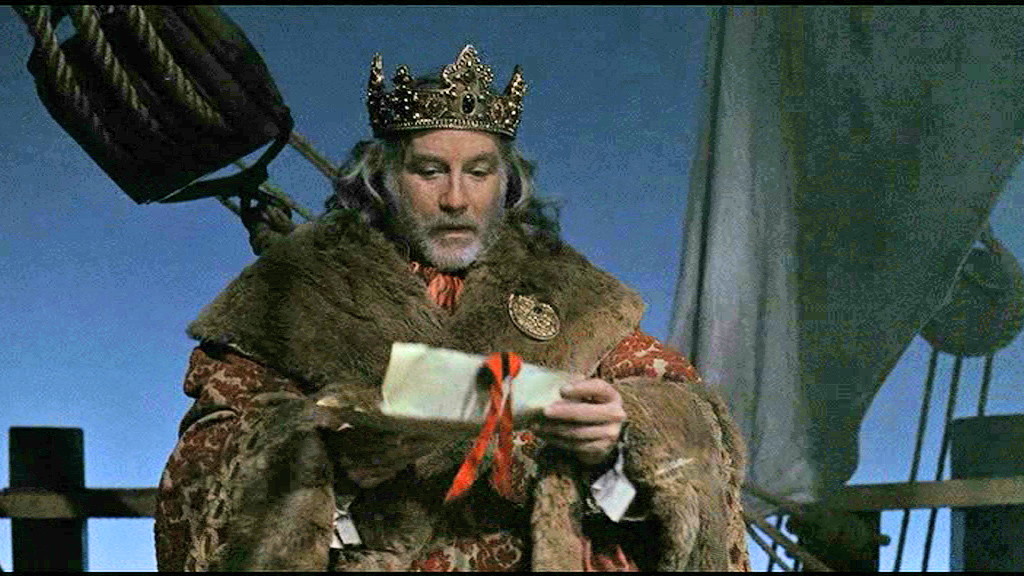.: The Rosencrantz & Guildenstern Tarot :.Tarot archetypes abound (with intriguing twists) in Tom Stoppard's absurdist film Rosencrantz and Guildenstern Are Dead (1990). A complement to Hamlet, this witty, funny, and profoundly philosophical film follows two of Shakespeare's minor characters as they confront life's meaning or futility. The High Priestess presides over the proceedings in several forms: as a shadow behind a curtain, in the form of Hamlet's proposed suitress Ophelia (her face concealed by a bouquet), and invisibly upon a throne between two pillars.
The titular, interchangeable characters are twin Fool archetypes, but so is Hamlet himself. The difference is that while Hamlet plays the Fool to manipulate his uncle/father king and mother queen, Rosencrantz and Guildenstern are unwitting Fools, wandering through a fog of confounding intrigues. Here are two appearances of Hamlet playing the Fool:
Here are the Fools Rosencrantz and Guildenstern, as pawns of the king, contemplating the big picture but without comprehension, and dramatically blinded by draperies:
It could easily be argued that the bumbling Polonius, King Claudius' chief counsellor, is a Fool. But we see the ceremonious Polonius as an embodiment of the Hierophant.
Anyone familiar with Hamlet will instantly guess that the Tarot suits of Cups and Swords dominate the film, since poisoned chalices and sword fights figure prominently in the proceedings.
The suit of Coins is also prominent. At the beginning of the film, a flipped gold coin turns up heads 92 times in a row (absurd, yet possible according to the law of probability).
The Chariot appears in the form of a traveling theatre troupe's stage on wheels. Interestingly, the chariot is depicted as being pushed by the actors.
Death appears in multiple guises, including the famous skull of Yorick and a theatrical spook.
The Hanged Man is here more accurately the Hanged Men. This archetype appears twice: first, in a play-within-the-film when members of the theatrical troupe predict the tragic end of Rosencrantz and Guildenstern, and finally when our anti-heroes meet their ropey demise.
The scales of Justice appear in a humorous scene in which Rosencrantz (or is it Guildenstern?) seeks to demonstrate that a heavy ball and a feather will fall at the same speed. His physics experiment ends disastrously.
The Wheel of Fortune appears twice as a ship's wheel, both as a prop on the theatrical chariot and on the ship that takes Rosencrantz and Guildenstern to their deaths in England. We also see a Wheel of Fortune in a chandelier that hangs over Hamlet's head as he struggles between the forces of free will and fate.
Temperance appears as a pun on the word, with "temp" echoing the French for "time." Hence, the two chalices and theme of equilibrium in the Rider-Waite-Smith card are here symbolized by the bulbs of an hourglass. Hamlet gains time in this scene: at the desk with the hourglass, he switches the decree for his execution with one condemning Rosencrantz and Guildenstern.
ReversalsEspecially fascinating is the appearance of Tarot card reversals in the film: The King of Cups appears reversed when, carried by his clandestine lover the queen, he dramatically leans backward to seize the crown from off his dead brother's head.
The Hierophant Polonius appears "reversed" when he lies dead from Hamlet's Knight of Swords.
The Knight of Swords himself appears reversed when a theatrical prop is laid down.
The Lovers appear reversed when masked players swoon.
Other ShadesSome other intriguing tones or shades to the Tarot archetypes include: The Queen of Cups, who appears in a puppet show crying crocodile tears over the death of Hamlet's father. Her royal cup will turn out to be poisoned.
The Ace of Swords, which depicts a theatrical "trick blade."
The Ace of Coins, heated by a candle to reseal the wax on a royal decree for execution.
The Ace of Cups, which appears as a cup-and-ball toy, ominously exuding red smoke to symbolize poison.
The King of Cups, as portrayed by a player administering poison.
The King of Wands, as the troupe's director.
The Knight of Coins, who finds the gold coin that comes up heads 92 times in a row.
The Knight of Swords, most often appearing in the form of Hamlet, who famously pierces the eavesdropping Polonius through a tapestry.
The Knight of Cups, appearing as the English ambassador, who picks up a poisoned chalice as he delivers his message that Rosencrantz and Guildenstern are dead.
The Lovers, appearing in several guises, the most interesting occurring during a play-within-the-film. A mock Claudius leaps onto the queen's back after the death of her husband, the rightful king.
The Magician, as the troupe's director. He appears and disappears in a cloud of steam.
The Moon, a drowned Ophelia?
The Page of Cups, laughing heartily at the hijinks of the players.
The Page of Wands, as Rosencrantz (or is it Guildenstern?), who accidentally stumbles upon the secret of wind power.
The Ten of Coins, Rosencrantz's (or perhaps Guildenstern's) winnings after repeatedly wagering a coin toss of heads.
The Five of Cups, as a row of hanging pots that demonstrate (and also dramatically fail to demonstrate) the "Newton's cradle" phenomenon of physics.
The Three of Swords, held by a player.
The Two of Cups, held by a player portraying King Claudius. One of the cups contains poison.
The Two of Swords, merging with The Lovers, as a loving couple engages in a theatrical sword fight.
The Four of Swords, echoing the Rider-Waite-Smith card twice in the film, once when Hamlet visits his father's sepulchre and once when Rosencrantz (or Guildenstern?) ruminates upon a marble platform.
The Two of Wands, as flaming torches on the boat that transports Rosencrantz, Guildenstern, and Hamlet to England.
The King of Coins, giving Rosencrantz and Guildenstern fair warning of their imminent execution.
An eccentric lexicographer and scholar, Craig Conley is author of the Tarot of Portmeirion, Magic Words: A Dictionary (Weiser Books) and One-Letter Words: A Dictionary (HarperCollins). His website is OneLetterWords.com. ~ ~ ~
All of the above digital images are copyright Cinecom or its assigns, who reserves all rights thereto. The use of these images within the above analysis constitutes Academic Fair Use as defined by the U.S. Copyright Office. |
|
|
